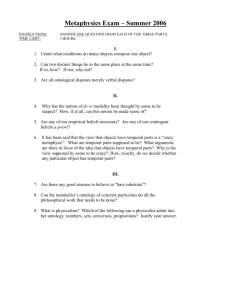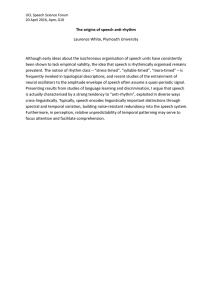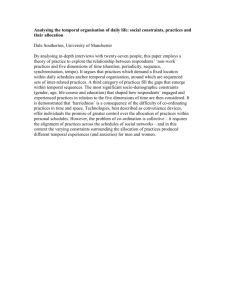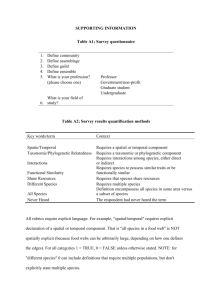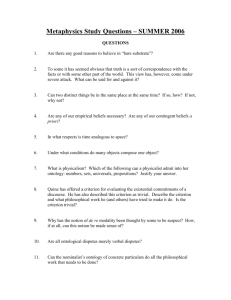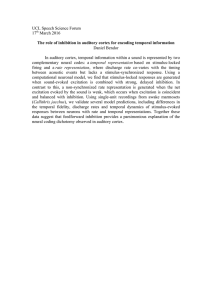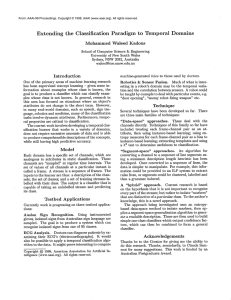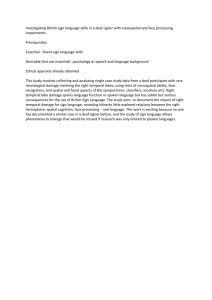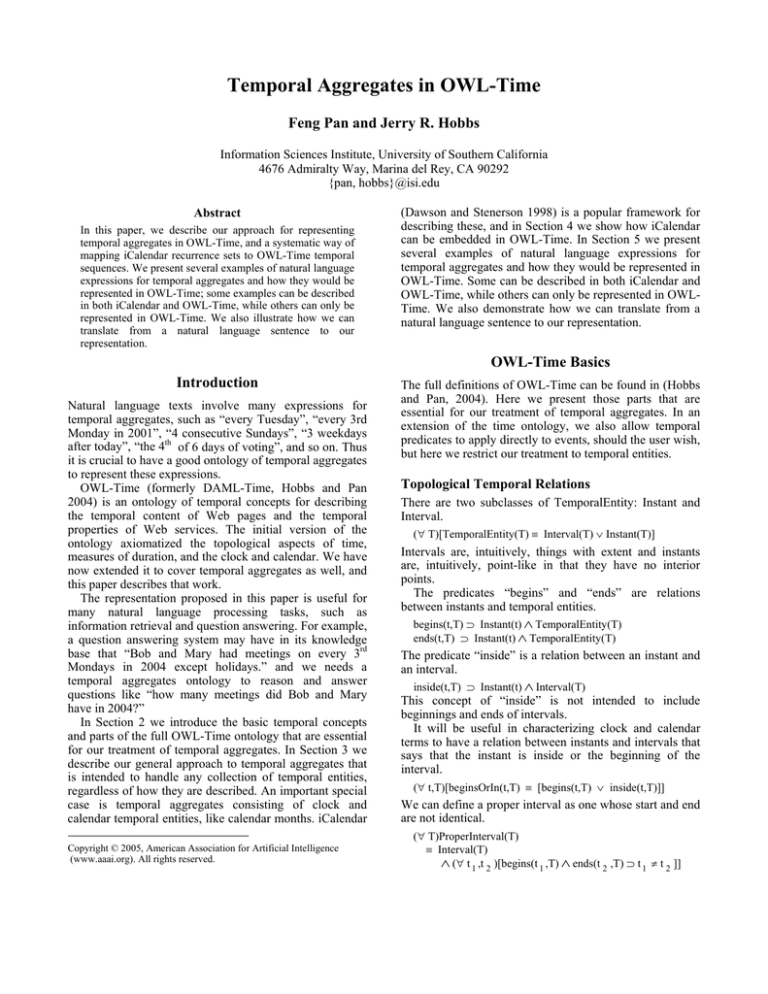
Temporal Aggregates in OWL-Time
Feng Pan and Jerry R. Hobbs
Information Sciences Institute, University of Southern California
4676 Admiralty Way, Marina del Rey, CA 90292
{pan, hobbs}@isi.edu
Abstract
In this paper, we describe our approach for representing
temporal aggregates in OWL-Time, and a systematic way of
mapping iCalendar recurrence sets to OWL-Time temporal
sequences. We present several examples of natural language
expressions for temporal aggregates and how they would be
represented in OWL-Time; some examples can be described
in both iCalendar and OWL-Time, while others can only be
represented in OWL-Time. We also illustrate how we can
translate from a natural language sentence to our
representation.
(Dawson and Stenerson 1998) is a popular framework for
describing these, and in Section 4 we show how iCalendar
can be embedded in OWL-Time. In Section 5 we present
several examples of natural language expressions for
temporal aggregates and how they would be represented in
OWL-Time. Some can be described in both iCalendar and
OWL-Time, while others can only be represented in OWLTime. We also demonstrate how we can translate from a
natural language sentence to our representation.
OWL-Time Basics
Introduction
Natural language texts involve many expressions for
temporal aggregates, such as “every Tuesday”, “every 3rd
Monday in 2001”, “4 consecutive Sundays”, “3 weekdays
after today”, “the 4th of 6 days of voting”, and so on. Thus
it is crucial to have a good ontology of temporal aggregates
to represent these expressions.
OWL-Time (formerly DAML-Time, Hobbs and Pan
2004) is an ontology of temporal concepts for describing
the temporal content of Web pages and the temporal
properties of Web services. The initial version of the
ontology axiomatized the topological aspects of time,
measures of duration, and the clock and calendar. We have
now extended it to cover temporal aggregates as well, and
this paper describes that work.
The representation proposed in this paper is useful for
many natural language processing tasks, such as
information retrieval and question answering. For example,
a question answering system may have in its knowledge
base that “Bob and Mary had meetings on every 3rd
Mondays in 2004 except holidays.” and we needs a
temporal aggregates ontology to reason and answer
questions like “how many meetings did Bob and Mary
have in 2004?”
In Section 2 we introduce the basic temporal concepts
and parts of the full OWL-Time ontology that are essential
for our treatment of temporal aggregates. In Section 3 we
describe our general approach to temporal aggregates that
is intended to handle any collection of temporal entities,
regardless of how they are described. An important special
case is temporal aggregates consisting of clock and
calendar temporal entities, like calendar months. iCalendar
Copyright © 2005, American Association for Artificial Intelligence
(www.aaai.org). All rights reserved.
The full definitions of OWL-Time can be found in (Hobbs
and Pan, 2004). Here we present those parts that are
essential for our treatment of temporal aggregates. In an
extension of the time ontology, we also allow temporal
predicates to apply directly to events, should the user wish,
but here we restrict our treatment to temporal entities.
Topological Temporal Relations
There are two subclasses of TemporalEntity: Instant and
Interval.
(∀ T)[TemporalEntity(T) ≡ Interval(T) ∨ Instant(T)]
Intervals are, intuitively, things with extent and instants
are, intuitively, point-like in that they have no interior
points.
The predicates “begins” and “ends” are relations
between instants and temporal entities.
begins(t,T) ⊃ Instant(t) ∧ TemporalEntity(T)
ends(t,T) ⊃ Instant(t) ∧ TemporalEntity(T)
The predicate “inside” is a relation between an instant and
an interval.
inside(t,T) ⊃ Instant(t) ∧ Interval(T)
This concept of “inside” is not intended to include
beginnings and ends of intervals.
It will be useful in characterizing clock and calendar
terms to have a relation between instants and intervals that
says that the instant is inside or the beginning of the
interval.
(∀ t,T)[beginsOrIn(t,T) ≡ [begins(t,T) ∨ inside(t,T)]]
We can define a proper interval as one whose start and end
are not identical.
(∀ T)ProperInterval(T)
≡ Interval(T)
∧ (∀ t 1 ,t 2 )[begins(t 1 ,T) ∧ ends(t 2 ,T) ⊃ t 1 ≠ t 2 ]]
There is a “before” relation on temporal entities, which
gives directionality to time. If temporal entity T 1 is before
temporal entity T 2 , then the end of T 1 is before the start
of T 2 . Thus, “before” can be considered to be basic to
instants and derived for intervals.
(∀ T 1 ,T 2 )[before(T 1 ,T 2 )
≡ (∃ t 1 ,t 2 )[ends(t 1 ,T 1 ) ∧ begins(t 2 ,T 2 ) ∧ before(t 1 ,t 2 )]]
The relations between intervals defined in Allen’s
temporal interval calculus (Allen 1984) can be defined in a
straightforward fashion in terms of “before” and identity
on the beginning and end points. It is a bit more
complicated than the reader might at first suspect, since
allowance has to be made for the possibility of infinite
intervals. Since one of the intervals could be infinite and
lack an end point, the relation between the end points has
to be dependent on their existence.
OWL-Time includes axioms defining the interval
relations
“intEquals”,
“intBefore”,
“intMeets”,
“intOverlaps”, “intStarts”, “intDuring”, “intFinishes”, and
their reverse interval relations: “intAfter”, “intMetBy”,
“intOverlappedBy”,
“intStartedBy”,
“intContains”,
“intFinishedBy”. For example, the definition of
“intEquals” is:
(∀ T 1 ,T 2 )[intEquals(T 1 ,T 2 )
≡ [ProperInterval(T 1 ) ∧ ProperInterval(T 2 )
∧ (∀ t 1 )[begins(t 1 ,T 1 ) ≡ begins(t 1 ,T 2 )]
∧ (∀ t 2 )[ends(t 2 ,T 1 ) ≡ ends(t 2 ,T 2 )]]]
Clock and Calendar
A day as a calendar interval begins at and includes
midnight, and goes until, but does not include, the next
midnight. This contrasts with a day as a duration which is
any interval that is 24 hours in length. The day as a
duration is dealt with in the full OWL-Time ontology; for
this paper we need only the day as a calendar interval.
Including the beginning but not the end of a calendar
interval in the interval may strike some as arbitrary. But we
get a cleaner treatment if, for example, all times of the
form 12:xx am, including 12:00 am, are part of the same
hour and day, and all times of the form 10:15:xx, including
10:15:00, are part of the same minute. Clock intervals are
described with the predicate “clockInt”:
clockInt(y,n,u,x)
This expression says that y is the nth clock interval of type
u in x. For example, the proposition “clockInt(10:03,3,
*Minute*,[10:00,11:00])” holds. Here u is a member of the
set of clock units, that is, one of *Second*, *Minute*, or
*Hour*. The larger interval x may not line up exactly with
clock intervals. In this case we take y to be the nth
complete clock interval of type u in x. In addition, there is
a calendar unit function with similar structure:
calInt(y,n,u,x)
This says that y is the nth calendar interval of type u in x.
For example, the proposition “calInt(12Mar2002,12,
*Day*,Mar2002)” holds. Here u is one of the calendar
units *Day*, *Week*, *Month*, and *Year*.
A distinction is made above between clocks and
calendars because they differ in how they number their
unit intervals. The first minute of an hour is labeled with 0;
for example, the first minute of the hour [10:00,11:00] is
10:00. The first day of a month is labeled 1; the first day of
March is March 1. We number minutes for the number just
completed; we number days for the day we are working
on. Thus, if the larger unit has N smaller units, the
argument n in “clockInt” runs from 0 to N-1; whereas, in
“calInt”, n runs from 1 to N. To state properties true of
both clock and calendar intervals, we can use the predicate
“calInt” and relate the two notions with the axiom
calInt(y,n,u,x) ≡ clockInt(y,n-1,u,x)
The names of months can be defined in terms of the
predicate “calInt”. For example, July is the seventh month
of a year.
July(m,y) ≡
calInt(m,7,*Month*,y) ∧ (∃ n,t) [calInt(y,n,*Year*,t)]
The top-level time interval (for modern applications) is
CE(z), which is the Common Era in time zone z. Thus, the
year 2005 in the Eastern Standard Time Zone is the y such
that “calInt(y, 2005, *Year*, CE(*EST*))”.
A week is any seven consecutive days. A calendar week,
by contrast, according to a commonly adopted convention,
starts at midnight, Saturday night, and goes to the next
midnight, Saturday night. That is, weeks start with Sunday.
(By contrast, the ISO 8061 standard week starts with
Monday.) There are 52 weeks in a year, but there are not
usually 52 calendar weeks in a year. Weeks are
independent of months and years. However, we can still
talk about the nth week in some larger period of time, e.g.,
the third week of the month or the fifth week of the
semester. To say a time interval is a calendar-week, we say
calInt(y,n,*Week*,x)
As it happens, the n and x arguments will often be
irrelevant when we only want to say that some period is a
calendar week, and not say which.
The day of the week is a calendar interval of type
*Day*. The nth day-of-the-week in a week is the nth day
in that interval.
dayofweek(y,n,x) ≡
calInt(y, n,*Day*,x)
∧
(∃ n1,x1) calInt(x,n,*Week*, x1)
The days of the week have special names in English, such
as Sunday, Monday, and so on. For example, Monday is
defined as follows:
dayofweek(y,2,x) ≡ Monday(y,x)
This says that y is the Monday of week x.
The ISO 8061 standard week is related to the traditional
week as follows:
0 < n < 7 ⊃ [isodayofweek (y,n,x) ≡ dayofweek(y,n+1,x)]
isodayofweek (y,7,x) ≡ Sunday(y,x)
Holidays can also be specified in this ontology. To say
that July 4 is a holiday one could write
(∀ d,m,y)[calInt(d,4,*Day*,m) ∧ July(m,y) ⊃ holiday(d)]
Holidays like Easter can be defined in terms of this
ontology coupled with an ontology of the phases of the
moon.
Standard notation for date lists the year, month, day, and
time zone. It is useful to define a predication for this.
dateOf(t,y,m,d,z)
≡ (∃d 1 ,m 1 ,y 1 ,e) [beginsOrIn(t,d 1 )
∧ calInt(d 1 ,d,*Day*,m 1 ) ∧ calInt(m 1 ,m,*Month*,y 1 )
∧ calInt(y 1 ,y,*Year*,e) ∧ CE(z) = e]
Dates of intervals can be defined similarly.
Temporal Aggregates
In this section, we assume the notation of set theory. Sets
and elements of sets will be ordinary individuals, and
relations such as "member" will be relations between such
individuals. In particular, we will use the relation
"member" between an element of a set and the set. We will
use the notation "{x}" for the singleton set containing the
element x. We will use the function “union” to refer to the
union operation between two sets. The function "card" will
map a set into its cardinality.
In addition, for convenience, we will make moderate use
of second-order formulations, and quantify over predicate
symbols. This could be eliminated with the use of an
"apply" predicate and axiom schemas systematically
relating predicate symbols to corresponding individuals,
e.g., the axiom schema for unary predicates p,
(∀ x)[apply(*p*,x) ≡ p(x)]
It will be convenient to have a relation "ibefore" that
generalizes over several interval and instant relations,
covering both "intBefore" and "intMeets" for proper
intervals.
(∀ T1,T2)[ibefore(T1,T2)
≡ [before(T1,T2) ∨ [ProperInterval(T1)
∧ ProperInterval(T2) ∧ intMeets(T1,T2)]]]
It will also be useful to have a relation "iinside" that
generalizes over all temporal entities and aggregates. We
first define a predicate "iinside-1" that generalizes over
instants and intervals and covers "intStarts", "intFinishes"
and "intEquals" as well as "intDuring" for intervals.
A temporal aggregate is first of all a set of temporal
entities, but it has further structure. The relation "ibefore"
imposes a natural order on some sets of temporal entities,
and we will use the predicate "tseq" to describe those sets.
(∀ s)[tseq(s) ≡ (∀ t)[member(t,s) ⊃ TemporalEntity(t)]
∧ (∀ t1,t2)[member(t1,s) ∧ member(t2,s)
⊃ [t1 = t2 ∨ ibefore(t1,t2) ∨ ibefore(t2,t1)]]]
That is, a temporal sequence is a set of temporal entities
totally ordered by the "ibefore" relation. A temporal
sequence has no overlapping temporal entities.
It will be useful to have the notion of a temporal
sequence whose elements all have a property p.
(∀ s,p)[tseqp(s,p) ≡ tseq(s) ∧ (∀ t)[member(t,s) ⊃ p(t)]]
The same temporal aggregate can be broken up into a set
of intervals in many different ways.
A minimal temporal sequence is one whose intervals
are maximal, so that the number of intervals is minimal.
We can view a week as a week or as 7 individual
successive days; the first would be minimal. We can go
from a non-minimal to a minimal temporal sequence by
concatenating intervals that meet.
(∀ s)[min-tseq(s)
≡ (∀ t1,t2)[member(t1,s) ∧ member(t2,s)
⊃ [t1 = t2 ∨ (∃ t)[ibefore(t1,t) ∧ ibefore(t,t2)
∧ ~member(t,s)]]]]
That is, s is a minimal temporal sequence when any two
distinct intervals in s have a temporal entity not in s
between them.
A temporal sequence s1 is a minimal equivalent temporal
sequence to temporal sequence s2 if s1 is minimal and
equivalent to s2.
(∀ s1,s2)[min-equiv-tseq(s1,s2)
≡ min-tseq(s1) ∧ tseq(s2)
∧ (∀ t,t2)[TemporalEntity(t) ∧ iinside-1(t,t2)
∧ member(t2,s2) ⊃ (∃ t1)[member(t1,s1) ∧ iinside(t,t1)]]]
We can now generalize "iinside-1" to the predicate
"iinside", which covers both temporal entities and temporal
sequences. A temporal entity is "iinside" a temporal
sequence if it is "iinside-1" one of the elements of its
minimal equivalent temporal sequence.
(∀ t,s)[iinside(t,s)
≡ [TemporalEntity(t) ∧ TemporalEntity(s) ∧ iinside-1(t,s)]
∨ [TemporalEntity(t) ∧ tseq(s)
∧ (∃ s1,t1)[min-equiv-tseq(s1,s) ∧ member(t1,s1)
∧ iinside-1(t,t1)]]]
We can define a notion of "isubset" on the basis of
"iinside".
(∀ s,s0)[isubset(s,s0)
≡ [tseq(s) ∧ tseq(s0) ∧ (∀ t)[member(t,s) ⊃ iinside(t,s0)]]]
That is, every element of temporal sequence s is inside
some element of the minimal equivalent temporal sequence
of s0.
We can also define a relation of "idisjoint" between two
temporal sequences.
(∀ s1,s2)[idisjoint(s1,s2)
≡ [tseq(s1) ∧ tseq(s2)
∧ ~(∃ t,t1,t2)[member(t1,s1) ∧ member(t2,s2)
∧ iinside(t,t1) ∧ iinside(t,t2)]]]
That is, temporal sequences s1 and s2 are disjoint if there
is no overlap between the elements of one and the elements
of the other.
The last temporal entity in a temporal sequence is the
one with any of the others "ibefore" it.
(∀ t,s)[last(t,s)
≡ [tseq(s) ∧ member(t,s)
∧ (∀ t1)[member(t1,s) ⊃ [t1 = t ∨ ibefore(t1,t)]]]]
More generally, we can talk about the nth element of
temporal sequence.
(∀ t,s)[nth(t,n,s)
≡ [tseq(s) ∧ member(t,s) ∧ natnum(n)
∧ (∃ s1)[(∀ t1)[member(t1,s1)
≡ [member(t1,s) ∧ ibefore(t1,t)]] ∧ card(s1) = n-1]]]
That is, the nth element of a temporal sequence has n-1
elements before it.
The predicate "ngap" will enable us to define
"everynthp" below. Essentially, we are after the idea of a
temporal sequence s containing every nth element of s0 for
which p is true. The predicate "ngap" holds between two
elements of s and says that there are n-1 elements between
them that are in s0 and not in s for which p is true.
(∀ t1,t2,s,s0,p,n) [ngap(t1,t2,s,s0,p,n)
≡ [member(t1,s) ∧ member(t2,s) ∧ tseqp(s,p)
∧ tseq(s0) ∧ isubset(s,s0) ∧ natnum(n)
∧ (∃ s1)[card(s1) = n-1 ∧ idisjoint(s,s1)
∧ (∀ t)[member(t,s1)
≡ [iinside(t,s0) ∧ p(t) ∧ ibefore(t1,t) ∧ ibefore(t,t2)]]]]]
The predicate "everynthp" says that a temporal sequence s
consists of every nth element of the temporal sequence s0
for which property p is true. It will be useful in describing
temporal aggregates like "every third Monday in 2001".
(∀ s,s0,p,n)[everynthp(s,s0,p,n)
≡ [tseqp(s,p) ∧ tseq(s0) ∧ natnum(n)
∧ (∃ t1)[nth(t1,1,s) ∧ ~(∃ t)[iinside(t,s0) ∧ ngap(t,t1,s,s0,p,n)]]
∧ (∃ t2)[last(t2,s) ∧ ~(∃ t)[iinside(t,s0) ∧ ngap(t2,t,s,s0,p,n)]]
∧ (∀ t1)[last(t1,s) ∨ (∃ t2) ngap(t1,t2,s,s0,p,n)]]]
That is, the first element in s has no p element n elements
before it in s0, the last element in s has no p element n
elements after it, and every element but the last has a p
element n elements after it.
The variable for the temporal sequence s0 is, in a sense,
a context parameter. When we say "every other Monday",
we are unlikely to mean every other Monday in the history
of the Universe. The parameter s0 constrains us to some
particular segment of time. (Of course, that segment could
in principle be the entire time line.)
The definition of "everyp" is simpler.
(∀ s,s0,p)[everyp(s,s0,p)
≡ (∀ t)[member(t,s) ≡ [iinside(t,s0) ∧ p(t)]]]
It is a theorem that every p is equivalant to every first p.
(∀ s,s0,p)[everyp(s,s0,p) ≡ everynthp(s,s0,p,1)]
We could similarly define "every-other-p", but the
resulting simplification from "everynthp(s,s0,p,2)" would
not be sufficient to justify it.
Embedding iCalendar Recurrence Sets in
OWL-Time
Internet Calendaring and Scheduling Core Object
Specification (iCalendar) is a widely supported standard
for personal data interchange. It provides the definition of
a common format for openly exchanging calendaring and
scheduling information across the Internet. The recurrence
set in iCalendar is the complete set of recurrence instances
for a calendar component. iCalendar recurrence sets are a
subset of OWL-Time temporal sequences.
We have developed a systematic way of mapping a
recurrence set in iCalendar to a temporal sequence in
OWL-Time. Here we demonstrate this on an illustrative
subset of recurrence sets.
As shown in the next section with natural language
examples, there are cases that can be expressed in OWLTime more accurately than in iCalendar, and there are also
cases that iCalendar can’t express, but OWL-Time can.
Moreover, embedding recurrence sets in OWL-Time gives
us access to the full ontology of time for temporal
reasoning.
A recurrence set s is defined by a recurrence rule r. We
express this as RecurrenceSetRule(s,r). First, we list the
properties of a recurrence rule r:
(∀ r) [rule(r)
⊃ (∃ tu,g) [freq(r)=tu ∧ TemporalUnit(tu) ∧ gap(g,r)]]
freq(r) corresponds to the FREQ property of recurrence
rules. Since it is a required property, it is defined as a
function mapping from a recurrence rule to a temporal
unit. For example, FREQ = WEEKLY will have a return
value of temporal unit *Week*.
gap(g,r) corresponds to the INTERVAL property of
recurrence rules; if it is missing, we assume it is given a
default value of 1 during the translation process from
iCalendar to OWL-Time.
(∀ r) [rule(r)
⊃ (∃ n) [count(n,r) ∧ natnum(n)]
∨ (∃ t,y,mo,d,h,mi,s,z) [until(t,r)
∧ timeOf(t,y,mo,d,h,mi,s,z)]]
count(n,r) corresponds to the COUNT property of
recurrence rules. until(t,r) corresponds to the UNTIL
property of recurrence rules. It is required in iCalendar that
either UNTIL or COUNT may appear in a recurrence rule,
but they must not occur in the same rule.
Then, we specify the optional properties of a recurrence
rule as in:
(∀ r, ls) [rule(r) ∧ bysecond(ls, r)
⊃ (∀ s) [member(s, ls) ⊃ integer(s) ∧ 0<=s<=59]]
corresponding to the BYSECOND property of recurrence
rules. BYMINUTE, BYHOUR, and so on are defined
similarly.
Now we can map from the recurrence set generated by a
recurrence rule r with either COUNT or UNTIL to a
temporal sequence s:
(∀ r,n,s,g) [RecurrenceSetRule(s,r) ∧ count(n,r) ∧ gap(g,r)
⊃ (∃ s0) [card(s)=n ∧ everynthp(s,s0,map2p(freq(r)),g)]]
(∀ r,t,s,g) [RecurrenceSetRule(s,r) ∧ until(t,r) ∧ gap(g,r)
⊃ (∃ t’,s0) [last(t’,s0) ∧ ends(t,t’)
∧ everynthp(s,s0,map2p(freq(r)),g)]]
“map2p” is a function that maps from temporal units to
their corresponding unary predicate names. For example,
map2p(*year*) = year1, where (∀ y) [year1(y) ≡ (∃ n,x)
[calInt(y,n,*Year*,x)]]
iCalendar can express very complicated recurrence sets.
For example, “The 1st and 2nd hours of the 4th and 5th
months of every year” will have a recurrence rule in which
BYHOUR = 1, 2, BYMONTH = 4, 5, and FREQ =
YEARLY.
To formalize this we need recursion through the
sequence of temporal units (with the predicate
“everyithtempunit”) and recursion through the list of
integers associated with each temporal unit (with the
predicate “byTulistRecurs”). We do the latter first.
(∀ s,ls,r,tu,g) [RecurrenceSetRule(s,r) ∧ bytempunit (ls,r,tu)
∧ gap(g,r)
⊃ (∃ s’,s0) [everynthp(s’,s0,map2p(freq(r)),g)
∧ byTulistRecurs(s,ls,s’,tu,freq(r))]]
(∀ s,ls,s’,tu,tu’) [byTulistRecurs (s,ls,s’,tu,tu’) ∧ card(ls) > 1
⊃ (∃ s1,ls1,i,si,i) [ls = union({i},ls1) ∧ ~member(i,ls1)
∧ everyithtempunit(si,s’,i,tu,tu’) ∧ s = union(s1,si)
∧ byTulistRecurs(s1,ls1,s’,tu,tu’)]]
“tulevel” is a function mapping from a temporal unit to its
level value according to a hierarchy. For example,
tulevel(*second*) = 1, tulevel(*month*) = 5.
“level2tu” is an inverse function of “tulevel”. It maps
from the level value to the associated temporal unit. For
example, level2tu(1) = *second*, level2tu(5) = *month*.
Month days, year days, and weeks are axiomatized
specially.
iCalendar allows one to specify lists of dates/times as
well, with the attributes RDATE and EXDATE. These are
translated into simple temporal sequences. A recurrence set
is generated by generating recurrence sets specified by the
RRULE and/or RDATE attributes and by the EXRULE
and/or EXDATE attributes, subtracting the latter from the
former, and constraining the result by the DTSTART
attribute.
Base case of the recursion:
(∀ s,s’,i,tu,tu’) [byTulistRecurs(s,{i},s’,tu,tu’)
⊃ everyithtempunit(s,s’,i,tu,tu’)]
“bytempunit” is a generalized relation from bysecond,
byminute, and so on. It is a relation among a recurrence
rule r, a temporal unit tu, and a list of values associated
with BYxxx with that temporal unit. For example,
(∀ ls,r) [bytempunit(ls,r,*Second*) ≡ bysecond(ls,r)]
“byTulistRecurs” is a relation among two temporal
sequences (s, s’), their temporal units (tu, tu’), and a list of
values associated with tu.
“everyithtempunit” is an important relation among two
temporal sequences (s, s’), their temporal units (tu, tu’),
and an integer value i. For example, everyithtempunit(s,s’,
2,*Month*,*Year*) specifies the members of temporal
sequence s are the every 2nd month, i.e. February, of the
members (with temporal unit of *Year*) of temporal
sequence s’.
It’s possible to have a gap between FREQ and BYxxx,
for example, “the 1st two hours in every month”, which can
be expressed in iCalendar with FREQ = MONTHLY,
BYHOUR = 1, 2. To paraphrase this sentence, we get “the
1st two hours of the 1st day of every month”. In order to
handle
this
case,
we
define
the
predicate
“everyithtempunit” recursively:
(∀ s1,s2,i,tu1,tu2) [everyithtempunit (s1,s2,i,tu1,tu2)
∧ tulevel(tu2) > tulevel(tu1)+1 ∧ tu1 ≠ *Monthday*
∧ tu1 ≠ *Yearday* ∧ tu1 ≠ *Week*
⊃ (∃ s’) [everyithtempunit (s1,s’,i,tu1,level2tu(tulevel(tu2)-1))
∧ everyithtempunit (s’,s2,1,level2tu(tulevel(tu2)-1),tu2)]]
Base case:
(∀ s1,s2,i,tu1,tu2) [everyithtempunit (s1,s2,i,tu1,tu2)
∧ tulevel(tu2)=tulevel(tu1)+1 ∧ tu1 ≠ *Monthday*
∧ tu1 ≠ *Yearday* ∧ tu1 ≠ *Week*
⊃ (∀ t1) [member(t1,s1) ≡
(∃ t2) [member(t2,s2) ∧ iinside-1(t1,t2)
∧ calclockInt(t1,i,tu1,t2)]]]
where calclockInt(y,n,u,x) ≡ calInt(y,n,u,x) ∨ clockInt(y,n,u,x)
Some Natural Language Examples
In the previous section, we’ve shown how iCalendar
statements can be systematically mapped to OWL-Time
predicates; in this section we demonstrate how these
predicates in OWL-Time can be used to express natural
language expressions.
We will first take an example from iCalendar, and show
how to express it in OWL-Time. Then we will show an
example that OWL-Time can do better than iCalendar.
After showing an example that iCalendar can’t handle, but
OWL-Time can, we will finally show more natural
language expressions that can be represented using OWLTime predicates.
1) “Every other week on Monday, Wednesday and
Friday until December 24, 1997, but starting on Tuesday,
September 2, 1997.” (Taken from RFC 2445 page 120.)
DTSTART;TZID=US-Eastern:19970902T090000
RRULE:FREQ=WEEKLY;INTERVAL=2;UNTIL=19971224
T000000Z;WKST=SU;BYDAY=MO,WE,FR
iCalendar uses “FREQ=WEEKLY;INTERVAL=2” to
represent “every other week”, and uses “BYDAY=MO,
WE,FR” to get “every Monday, Wednesday, and Friday”.
WKST specifies the start of the week, which is Sunday in
this example.
This example can be expressed in OWL-Time as a
temporal sequence s for which the following is true:
(∃ s,s’,T,t1,t2) [everynthp(s’,{T},Week1,2) ∧
byTulistRecurs(s,{1, 3, 5},s’,*Day*,*Week*) ∧ begins(t1,T)
∧ ends(t2,T) ∧ dateOf(t1,1997,9,2)
∧ dateOf(t2,1997,12,24)]
where (∀ w) [Week1(w) ≡ (∃ n,x) [calInt(w,n,*Week*,x)]]
s is the desired temporal sequence representing “every
Monday, Wednesday, and Friday” of s’ which is a
temporal sequence of “every other week from 09/02/1997
to 12/24/1997”.
2) “Every 3rd Monday in 2001.”
This looks like a simple example, but iCalendar can’t
express it exactly. Though iCalendar can express “the 3rd
Monday” using BYDAY=3MO, it can’t express “every 3rd
Monday”. In order to express this phrase in iCalendar, we
have to paraphrase it first to: “Every 3rd week on Monday
in 2001”.
However, the paraphrased one is not exactly the same as
the original, since it depends on what the first week is. In
iCalendar, the first week is defined as the week that
“contains at least four days in that calendar year”. Based
on this definition, however, if the first week starts from a
Tuesday, the first 3rd Monday will be different from the
first Monday of the 3rd week!
In order to express year 2001, in iCalendar it has to
specify the start date (01/01/2001) using DTSTART and
the end date (12/31/2001) using UNTIL. Here is how to
express “Every 3rd week on Monday in 2001” in
iCalendar:
DTSTART;TZID=US-Eastern:20010101T000000
RRULE:FREQ=WEEKLY;INTERVAL=2;UNTIL=20011231
T000000Z;WKST=SU;BYDAY=MO
In OWL-Time, this example can be expressed very
straightforwardly as a temporal sequence s for which the
following is true:
(∃ y,z) [yr(y,2001,CE(z)) ∧ everynthp(s,{y},Monday1,3)]
(∃ s,s1,s2,s0) [everyp(s1,s0,Year1) ∧
everynthp(s2,s1,Month1,4) ∧ everynthp(s,s2,Monday1,2)]
where (∀ y) [Year1(y) ≡ (∃ n,x) [calInt(y,n,*Year*,x)]]
(∀ m) [Month1(m) ≡ (∃ n,x) [calInt(m,n,*Month*,x)]]
• “Four consecutive Mondays.”
(∃ s,s0) [everyp(s,s0,Monday1)
∧
card(s) = 4]
In order to translate from natural language sentences to our
representation, we first run a semantic parser to get a
“surface” logical form from a given sentence. Then we use
some additional rules to map from the “surface” logical
form to our domain ontology. For example, given the
above input sentence, the “surface” logical form would be:
(∃ s,d) [plur(d,s) ∧ Monday1(d) ∧ consecutive(s,Monday1)
∧ card(s) = 4]
“plur” takes as its arguments both a set and a representative member of the set. “consecutive” takes as its
arguments both a set and the property of the set, meaning
that the members of the set are not only consecutive but
also share a certain property. “card” is a function that
returns the cardinality/size of the set.
Then we map the above “surface” logical form to our
ontology predicates by applying the following rule:
(∀ s,p)consecutive(s, p) ≡ (∃ s0) everyp(s,s0,p)
where (∀ d) [Monday1(d) ≡ (∃ w) [Monday(d,w)]]
3) “Every Monday that’s a holiday.”
There is no way in iCalendar to express “conditional
temporal aggregates” or any temporal aggregates that are
not in a form of standard temporal units, such as
“holidays”, “voting dates”, “days with classes”, “months
starting with a Monday”, and so on.
OWL-Time, however, can express any kind of temporal
aggregates, using the argument p in “everynthp(s,s0,p,n)”
or “everyp(s,s0,p)”. All the conditions and non-temporalunit concepts can be captured using this p.
For example, we can express “Every Monday that’s a
holiday” in OWL-Time as a temporal sequence s for which
the following is true:
(∃ s,s0) [everyp(s,s0,HolidayMonday)]
where (∀ d) [HolidayMonday(d)
≡ (∃ w) [Monday(d,w)] ∧ holiday(d)]
4) More natural language expressions represented in
OWL-Time are as follows, where s is the set
corresponding to the noun phrase:
• “The past three Mondays.”
(∃ s,s0,t) [everyp(s,s0,Monday1) ∧ card(s) = 3 ∧ last(t,s0)
∧ ends(nowfn(D),t)]
In our treatment of temporal deictics, the function “nowfn”
maps a document d into the instant or interval viewed as
“now” from the point of view of that document, and D is
the document this phrase occurs in.
• “Every other Monday in every 4th month in every year.”
Conclusion
In this paper, we have described our work of representing
temporal aggregates in OWL-Time, and showed how
iCalendar recurrence sets can be embedded in OWL-Time.
Examples are also showed to illustrate how it can be used
to represent natural language expressions for temporal
aggregates.
Acknowledgements
This work was supported by the Advanced Research and
Development Activity (ARDA) under DOD/DOI/ARDA
Contract No. NBCHC040027. Any opinions, findings and
conclusions or recommendations expressed in this material
are those of the authors and do not necessarily reflect the
views of the ARDA or the Department of Interior.
References
Allen, J.F. 1984. Towards a general theory of action and
time. Artificial Intelligence 23, pp. 123-154.
Dawson, F. Stenerson, D. 1998. Internet Calendaring and
Scheduling Core Object Specification (iCalendar),
RFC2445, Internet Society.
Hobbs, J. R. and Pan, F. 2004. An Ontology of Time for
the Semantic Web. ACM Transactions on Asian Language
Processing (TALIP) Vol. 3, No. 1, pp. 66-85.

